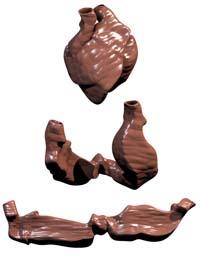Open the heart

The strength of the guild has never been small. And it also works in science. It is true that throughout history many non-professional researchers have made great contributions to science, even outside the guild. But at the same time, it is true that, in most cases, the scientific community does not accept these works immediately, precisely because they were born outside the guild. It is a meeting between two worlds, the amateur researcher and the scientific community, and both have reasons to act as they play.
There are spectacular examples. Spanish doctor Francesc Torrent Guasp took more than 20 years to publicly accept the investigations carried out at his home. When he got it he died of a heart attack in a congress full of cardiologists. They couldn't do anything. Ironic.
The discovery of Torrent was surprising. He cooked the cow's hearts and "flashed" the muscle with his hands. Thus he discovered that the whole heart is formed by a single fiber, wound in the form of a helix, to have a heart shape. Origami was like a work, but not of paper, but of muscle fibers.
As the systole and diastole has traditionally been understood, it is difficult to explain, for example, how blood gets displacement to the feet. A conventional pump would not. On the contrary, the structure found by Torrent explains. The heart pumps the blood in the systole as when a kitchen bayette tightens to remove the water and makes an active relaxation to absorb the blood back. It is the result of having a single twisted muscle.
In addition, the Torrent model provides a heart map to look for the exact location of any problem. Torrent's work also had a lot of information for surgeons. In cardiac valve operations, for example, it serves to know where the muscle is cut to cause as little invasion and damage as possible.
The problem was to publish all these results. In fact, in addition to professionals, amateur researchers also have the possibility of publishing articles in specialized journals that are accepted by the editors. However, it is difficult to keep the bibliography updated, maintain scientific debates and appropriate the language of science.
The occurrences of a genius
Albert Einstein's work is an example. When he sent four prestigious articles from 1905 that revolutionized the world of physics, he worked in Bern's patent office. He was far from the academic environment, but he was accepted with articles in the journal Annalen der Physik and little by little Einstein's revolution was launched.
Torrent had the scientific community farther than Einstein. Nor did he see the possibility of publishing in specialized magazines, so he decided to write monographs with the results of the research and publish them paying from his pocket. "To keep track of it," said Paco Torrent, his son, in a documentary on TV3.
However, the most common way to spread the work was through talks. He gave numerous lectures in the United States and Spain. The reception of the public was not always good. Torrent did not know how to defend the discovery scientifically. He presented to the public the model of a heart and showed how to display a single fiber to make it visible, that was his main argument. The public criticized him frequently and sometimes even ridiculed him.
Surely that criticism was sometimes an abuse. But professional scientists do not have an easy job in these cases. Before a supposedly revolutionary theory, they must be prudent.
In this sense, the case of William Herschel can be compared with that of Torrent. XVIII. Amateur astronomer of the nineteenth century, he dedicated hours to the telescope. One night he discovered Uranus, the first planet that is not seen at first sight. He presented his discovery at the Royal Society of London, not knowing very well what that star was, and put great obstacles on him. On the one hand, it was not easy to recognize that there may be new planets if they are not seen. And on the other hand, in a previous letter Herschel himself said that he had seen forests on the Moon (and scientists already knew that the Moon had no atmosphere, there could be no trees).
The scientists had founded reasons to rule out Herschel's observation, although he actually found Uranus. And they were in a situation similar to that of Torrent.
In 1959, Torrent began investigating in the United States, but feared that the results would be stolen and returned to Spain with all the data under his arm. He subsequently repented of this decision, but it was late for it. He only had to keep the investigation at home, with very slow and few resources.
The case of Torrent is a topic of profound reflection, since his ideas have not yet been fully extended. Scientists have internalized the relativity and existence of Uranus, for example, but the new model of the heart is only 30 years old.
Buletina
Bidali zure helbide elektronikoa eta jaso asteroko buletina zure sarrera-ontzian











